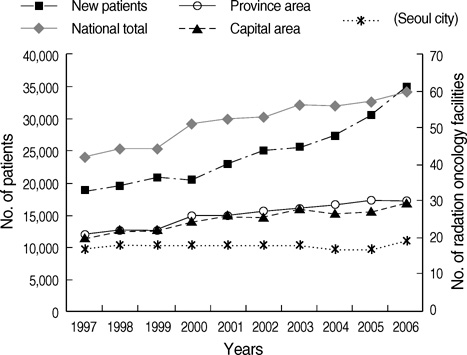J Korean Med Sci.
2009 Dec;24(6):1165-1169. 10.3346/jkms.2009.24.6.1165.
Clinical Characteristics of Radiation Oncology in Korea during Past 10 Years
- Affiliations
-
- 1Korea Institute of Radiological & Medical Sciences, Division of Radiation Cancer Research, Research Institute of Radiological & Medical Sciences, Seoul, Korea. mskim@kcch.re.kr
- 2Department of Radiation Oncology, Korea Cancer Center Hospital, Seoul, Korea.
- KMID: 1783149
- DOI: http://doi.org/10.3346/jkms.2009.24.6.1165
Abstract
- To understand trends in the clinical characteristics of radiation oncology over the last 10 yr in Korea, annual survey questionnaires were sent to all of Korean radiation oncology facilities since 1990. Questionnaires addressed basic radiation therapy facilities and the clinical information. Responses were obtained from all facilities, and data collected from 1997 to 2006 was analyzed. The numbers of new patients that have undergone radiation therapy and the numbers of hospitals with a department of radiation oncology have steadily increased over the past 10 yr, and totaled 37,215 patients and 60 hospitals, respectively, in 2006. However, the proportion of patients irradiated among total cancer patients has remained below 30% over the last 10 yr. The numbers of prostate cancer, breast cancer, and hepatoma have increased by more than 3 fold over the past 10 yr. Moreover, the percentage of irradiated patients treated by brachytherapy was 10.3% in 1997, but this gradually fell to only 4.2% in 2006. The information collected described the role played by radiation oncology in Korea. Continuous surveys are required to enable trends to be detected.
Keyword
MeSH Terms
Figure
Cited by 1 articles
-
The Clinical Status of Radiation Therapy in Korea in 2009 and 2013
Jin-Kyu Kang, Mi-Sook Kim, Won-Il Jang, Hee Jin Kim, Chul Koo Cho, Hyung Jun Yoo, Young Seok Seo, Eun Kyung Paik, Yu Jin Cha
Cancer Res Treat. 2016;48(3):892-898. doi: 10.4143/crt.2015.370.
Reference
-
1. Park CI. The status of radiation therapy in Korea. Int J Radiat Oncol Biol Phys. 1996. 36:1271–1274.2. You SY, Kim MS, Ji YH. National statistics of radiation oncology in Korea (1997). J Korean Soc Ther Radiol Oncol. 1998. 16:531–535.3. You SY, Kim MS, Ji YH, Cho CK, Ryu HJ, Yang KM. National statistics of radiation oncology in Korea (1998). J Korean Soc Ther Radiol Oncol. 1999. 18:73–77.4. You SY, Kim MS, Ji YH, Cho CK, Yang KM, Ryu HJ. National statistics of radiation oncology in Korea (1999-2001). J Korean Soc Ther Radiol Oncol. 2004. 22:234–236.5. Kim MS, Ji YH, You SY, Cho CK, Yang KM, Ryu HJ. National statistics of radiation oncology in Korea (2002-2004). J Korean Soc Ther Radiol Oncol. 2006. 24:77–80.6. Kim MS, Ji YH, You SY, Cho CK, Yang KM, Ryu HJ, Song YS. National statistics of radiation oncology in Korea (2005). J Korean Soc Ther Radiol Oncol. 2006. 24:207–209.7. Kang JO. Number of radiation oncologists in Korea, adequate or surplus? Cancer Res Treat. 2006. 38:61–65.
Article8. Huh SJ. Current status of the infrastructure and characteristics of radiation oncology in Korea. Jpn J Clin Oncol. 2007. 37:623–627.
Article9. Kim MS, Yoo SY, Cho CK, Yoo HJ, Yang KM, Ji YH, Kim DJ. The structure of Korea radiation oncology in 1997. J Korean Soc Ther Radiol Oncol. 1999. 17:172–178.10. Sophie RP, Thierry P, Michel M, Marie-Helene RD, Brigitte D, Beatrice F. Infrastructure of radiation oncology in France: a large survey of evolution of external beam radiotherapy practice. Int J Radiat Oncol Biol Phys. 2005. 61:507–516.11. Teshima T, Owen JB, Hanks GE, Sato S, Tsunemoto H, Inoue T. A comparison of the structure of radiation oncology in the United States and Japan. Int J Radiat Oncol Biol Phys. 1996. 34:235–242.
Article12. HIRA Statistic Data. Available at: http://www.hira.or.kr/.13. Kim GT. Cancer incidence in Korea 1999-2001. 2005. Republic of Korea: Ministry of Health & Welfare;Also, Available at: http://stat. mw.go.kr/.14. Jean B, Lawrence RC, Hanks GE. The structure of radiation oncology in the United States in 1994. Int J Radiat Oncol Biol Phys. 1997. 39:170–185.15. Shibuya H, Tsujii H. The structure characteristics of radiation oncology in Japan in 2003. Int J Radiat Oncol Biol Phys. 2005. 62:1472–1476.
- Full Text Links
- Actions
-
Cited
- CITED
-
- Close
- Share
- Similar articles
-
- Past in Radiation Oncology
- Journey to hypofractionation in radiotherapy for breast cancer: critical reviews for recent updates
- Less is more: level IB-sparing radiation therapy in nasopharyngeal cancer
- Advancing radiation therapy through smartwatch technology to monitor anxiety
- Stereotactic body radiation therapy for pancreatic cancer: a potential ally in the era of immunotherapy?




